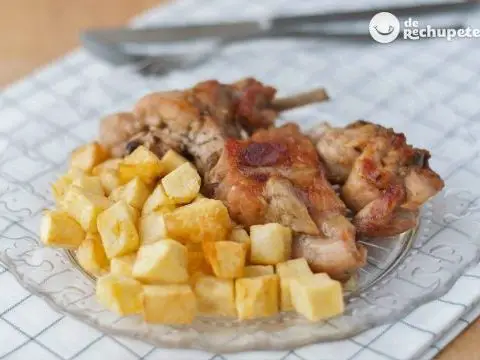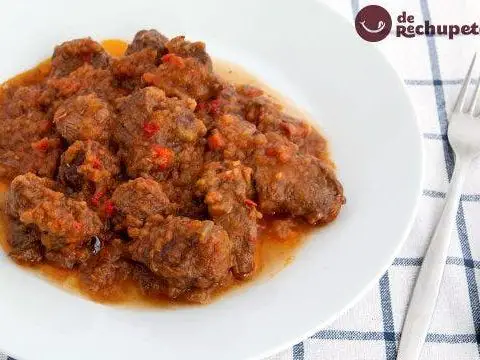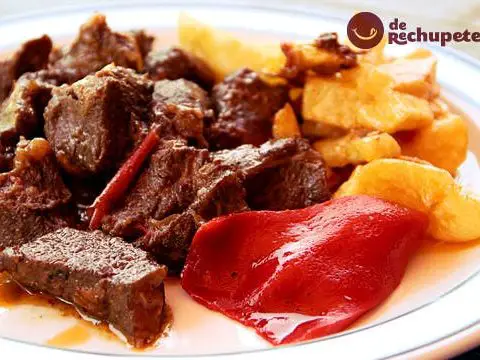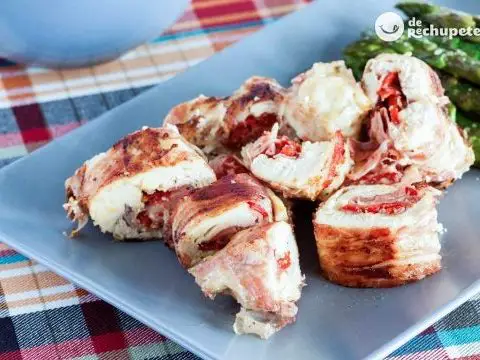
Info.
- Half
- 150 minutes
- For 6 people
- 2.7 € / person
- 320kcal per 100g.
How to make Goulash, Goulash, Gulyás (which would come to mean “shepherd of oxen”). This meat stew recipe is a spicy dish originating in Hungary.
It is one of the oldest stews or meat stews of the Austro-Hungarian empire, originally made from meat, onions and butter. With the passage of time it was evolving and adding new ingredients, from the eighteenth century this stew incorporates potatoes, red peppers, tomatoes and spices, but what gives it its differential characteristic today is the use of paprika or paprika .
In some cases, wine and flour are added to thicken the sauce, and in Hungary, where it is a national dish, it is usually accompanied with sour cream. Sometimes it can be a thick stew, and other times more soupy, almost a meat soup. Nowadays, if you are not a purist of this dish, it can be done with the type of meat that you like: veal, game meats, such as hare, rabbit, wild boar, pork, lamb (very good) or with chicken, imagination to power.
It is not clear if the dish was originally a soup or a ragout , it depended on the amount of water used in the last cooking, depending on the season or season of preparation. The dish became popular throughout the Austro-Hungarian Empire when a regiment in which a large number of shepherds from the Hortobary steppe (in eastern Hungary) performed their military service was transferred to Vienna and from this city the fashion of the goulash spread to everyone.
Now we can find it as a national dish not only in Hungary , but also in neighboring countries, such as Slovenia and others in central Europe (Slovakia, the Czech Republic, Austria, Northern Italy), the Balkans (Croatia and Serbia) and in other countries. from the region (Ukraine, Romania).
Currently the Goulash is associated with the use of paprika as an essential ingredient, although not of the correct everything. In Hungary a distinction is made between various preparations that contain paprika, the aforementioned Gulyas or Goulash , which can be either a soup or a stew.
The Porkolk which is a stew characterized by onion, the Tokany , a stew with little paprika and onion and with the presence of various vegetables. In short, all dishes that contain paprika and milk cream are called Paprikache . These stews are traditionally prepared in a special cauldron ( bogracs ), with ingredients easy to find in any market or supermarket. I hope you like it and prepare it at home, I assure you that it is delicious.
Preparation of the Hungarian Goulash
- When buying the meat, ask the butcher to cut it into regular pieces for stew and to clean it, to remove the excess fat. You will have a few pieces of 20 g more or less. If we buy the whole meat to cook, I recommend cutting it at home into pieces of 2-3 cm, do not forget to review and clean the possible remains of fat, tern and bones.
- Season the meat with salt and flour. Once floured and shaken, we will fry it in the pot where we are going to prepare the stew. Heat the extra virgin olive oil in a saucepan, add the meat and mark the pieces until they are well browned, it will release part of its juice. We remove the meat and reserve. Remains of the flour will remain in the oil that we have used to mark the meat, it will serve to thicken the sauce in the future cooking of the stew.
- Peel the garlic, onion and leek, and chop very finely. Fry all the vegetables in the same oil where we have browned the meat for about 10 minutes over low heat.
- When the sauce is well browned add a good tablespoon of paprika. This is the secret of an excellent Hungarian goulash, the quality of the paprika, although if it is not Hungarian we can use paprika from La Vera , which has a delicious smoky touch. We remove everything well at low temperature so that it does not burn us.
- Peel the carrots and wash the red pepper. We cut the carrots as thin as possible (this will be done much earlier in our stew) and the pepper in very small cubes. We cut the tomatoes in half and grate until we have only the pulp of it. We add these ingredients to the previous sofrito and stir everything well with a wooden spoon mixing the flavors.
- Chop the fresh parsley as finely as possible. We add a tablespoon of cumin powder (optional, I love the touch of this spice), parsley and Hungarian peppers (if you do not find them replace them with chili or cayenne, as long as you like the spicy touch that gives the stew ). We stir everything gently to bring the flavors together.
- We add the pieces of meat that we have reserved and add a glass of red wine, in my case a good mention of the Ribeira Sacra to give power to the flavor of the stew and an impressive color.
- Add the bay leaves and rectify salt and pepper. Let it reduce a little, about 10-15 minutes over medium heat.
- We cover everything with the rest of the wine and if you want the slightly softer stew, you can substitute part of the wine for meat broth or a little water.
- We cook over low heat until the liquid is reduced and the meat is tender, about 2 hours. It is important that you stir from time to time so that it does not stick to the bottom of the pan. If you prepare it the day before, the best way to heat it is to use the same saucepan over very low heat, stirring occasionally.
- We serve the Hungarian goulash very hot with a little chopped parsley on top, accompanied by bread, because the sauce in this recipe is great. If you like brothier, increase the amount of broth in the stew and take it as soup.
- Optionally (I don’t really like it), you can add a little sour cream when serving, which is the traditional way and how they take it in Hungary. Some people add liquid cream directly to the sauce, to thicken it, but it is not traditional. You can find variants where tomato and little paprika are not added, but since the Spanish brought tomato and paprika to the Austro-Hungarian empire, nobody imagines this dish without that peculiar flavor, what they call “tomatenpaprika”.
- You can accompany the goulash with white rice (it goes perfectly), with a garnish of späzli , which is a delicious fresh egg pasta or some fresh potato Gnocchi sauteed in butter.
I hope you like it and prepare it at home. Another ideal recipe now that Autumn has entered and it’s cold dear stews.






